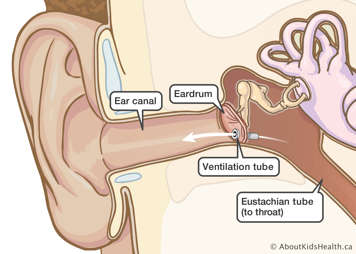The otolaryngologist has just drained fluid from your child's ears in a procedure called a myringotomy (say: mir-in-GOT-oh-mee). The doctor may also have put very tiny, soft tubes in your child's eardrums. These tubes will let fluid (liquid) drain easily from the ear. The tubes will help improve your child's hearing and reduce pain. They may also help your child develop fewer ear infections.
An otolaryngologist/head and neck surgeon (say: oh-toe-lar-ing-GOLL-oh-jist) is a doctor who specializes in problems with the ears, nose and throat.

Most children go home on the same day as the procedure
The operation usually takes 15 to 20 minutes.
Your child should experience little or no pain from this procedure.
If your child was booked for day surgery, your child will be able to go home after they are fully recovered from the sleep medicine called a general anesthetic. Your child's nurse will let you know when your child is able to go home. This is usually about four to five hours from when your child arrived at the hospital.
Taking care of your child at home
Fluid may leak from your child's ear
Your child's ears may leak fluid for three or four days after the tubes are put in. This fluid may be grey or brown and may also be smelly. This is normal.
The tubes will stay in your child's ears for several months
The tubes will eventually fall out, but you may not see them because they are so small.
Sometimes the tubes will need to be taken out by the otolaryngologist. If your child's hearing gets worse after several months, it could mean that the tubes have fallen out or become blocked and fluid has built up again. If this happens, please call your child's family doctor.
Cleaning your child's ear
Do not put anything into your child's ear
Putting something into your child's ear, like a cotton swab, could tear a hole in your child's eardrum. To clean your child's ear, use a damp clean cloth to wipe the fluid from your child's outer ear.
Your child can have a bath. To prevent ear infections, avoid getting soapy water into your child's ears. To help protect your child's ears, use silicone ear putty or ear plugs during bathing and shampooing. Your local drugstore will have these items. You can also buy custom-made ear plugs at any hearing aid centre. Ask the otolaryngology clinic staff for a list of these centres.
Medicines
Antibiotic ear drops
Your otolaryngologist may or may not order antibiotic ear drops for your child. Your nurse will show you how to put the antibiotic ear drops in your child's ear.
Pain medicine
Follow these instructions when your child goes home after the procedure.
You may give your child medicine for pain.
You may receive a prescription for pain medication before you leave the hospital. Follow the dosage instructions given to you by the pharmacist. Although these prescription pain medications can be beneficial, they are also potentially very dangerous if not used properly.
When using these medications, if you notice any changes in either breathing or level of drowsiness that concern you, stop the medication and seek medical attention. If your child is unresponsive, call 911 immediately.
Do not give your child over-the-counter medicine that may have a sedative effect (makes people sleepy) while giving the prescription for pain medicine. Examples of these medicines are decongestants and antihistamines. Discuss these medications with your pharmacist.
You may give your child acetaminophen if they have pain. Give the dose printed on the bottle for your child's age. Do not give your child ibuprofen or acetylsalicylic acid (ASA) for two weeks after the surgery. These medications could increase your child's risk of bleeding after the operation. Check with the nurse or doctor first before giving these medicines to your child.
Your child can go back to what they normally do on the day after the procedure
Your child can go back to day care or school the day after leaving the hospital, if your child is feeling well.
Swimming
While the ear tubes are in place, check with your child's doctor before letting your child go swimming. If the doctor says it is okay for your child to swim, be sure that your child uses ear putty or earplugs and wears a swim cap or swim band. To avoid water being forced into the ear, your child must not dive into the water while the ear tubes are in place.
Book a follow-up appointment with your otolaryngologist
On the day your child leaves the hospital or the next day, call the otolaryngology clinic to book a follow-up appointment with your child's doctor.
This appointment will usually be about two to four months after the tubes are put in. After this follow-up appointment, your child will need to see the doctor every six months until the tubes fall out.
Write down the time and date of your follow-up appointment here:
Reasons to call the otolaryngologist
You should call your otolaryngologist, the otolaryngology clinic or your family doctor if:
- Your child's ears leak fluid for more than four days after the operation.
- Your child has a fever over 38.5°C (101°F).
- Your child's ears start to leak fluid again after they have stopped leaking, or the color of the drainage changes to thick greenish pus with a strong smell.
- Your child's ears become sore.
If this is an emergency, or if you are worried, do not wait. Take your child to the closest emergency department.
Write down contact information here
My child's otolaryngologist is:
Phone number:
My family doctor is:
Phone number:
The otolaryngology clinic phone number is:
Ear infection
If you think your child has an ear infection, take them to see your family doctor. If there is fluid draining from your child's ear, they may need antibiotic ear drops.

